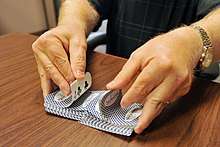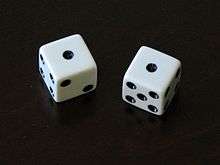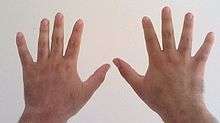Orders of magnitude (numbers)
This list contains selected positive numbers in increasing order, including counts of things, dimensionless quantity and probabilities. Each number is given a name in the short scale, which is used in English-speaking countries, as well as a name in the long scale, which is used in some of the countries that do not have English as their national language.

Smaller than 10−100 (one googolth)

- Mathematics – Writing: Approximately 10−183,800 is a rough first estimate of the probability that a monkey, placed in front of a typewriter, will perfectly type out William Shakespeare's play Hamlet on its first try.[1] However, taking punctuation, capitalization, and spacing into account, the actual probability is far lower: around 10−360,783.[2]
- Computing: The number 1×10−6176 is equal to the smallest positive non-zero value that can be represented by a quadruple-precision IEEE decimal floating-point value.
- Computing: The number 6.5×10−4966 is approximately equal to the smallest positive non-zero value that can be represented by a quadruple-precision IEEE floating-point value.
- Computing: The number 3.6×10−4951 is approximately equal to the smallest positive non-zero value that can be represented by an 80-bit x86 double-extended IEEE floating-point value.
- Computing: The number 1×10−398 is equal to the smallest positive non-zero value that can be represented by a double-precision IEEE decimal floating-point value.
- Computing: The number 4.9×10−324 is approximately equal to the smallest positive non-zero value that can be represented by a double-precision IEEE floating-point value.
- Computing: The number 1×10−101 is equal to the smallest positive non-zero value that can be represented by a single-precision IEEE decimal floating-point value.
10−100 to 10−30
- Mathematics: The chances of shuffling a standard 52-card deck in any specific order is around 1.24×10−68 (exactly 1/52!)[3]
- Computing: The number 1.4×10−45 is approximately equal to the smallest positive non-zero value that can be represented by a single-precision IEEE floating-point value.
10−30
(0.000000000000000000000000000001; 1000−10; short scale: one nonillionth; long scale: one quintillionth)
10−27
(0.000000000000000000000000001; 1000−9; short scale: one octillionth; long scale: one quadrilliardth)
10−24
(0.000000000000000000000001; 1000−8; short scale: one septillionth; long scale: one quadrillionth)
ISO: yocto- (y)
10−21
(0.000000000000000000001; 1000−7; short scale: one sextillionth; long scale: one trilliardth)
ISO: zepto- (z)
- Mathematics: The probability of matching 20 numbers for 20 in a game of keno is approximately 2.83 × 10−19.
10−18
(0.000000000000000001; 1000−6; short scale: one quintillionth; long scale: one trillionth)
ISO: atto- (a)
- Mathematics: The probability of rolling snake eyes 10 times in a row on a pair of fair dice is about 2.74×10−16.
10−15
(0.000000000000001; 1000−5; short scale: one quadrillionth; long scale: one billiardth)
ISO: femto- (f)
- Mathematics: The Ramanujan constant, is an almost integer, differing from the nearest integer by approximately 7.5×10−13.
10−12
(0.000000000001; 1000−4; short scale: one trillionth; long scale: one billionth)
ISO: pico- (p)
- Mathematics: The probability in a game of bridge of one player getting a complete suit is approximately 2.52×10−11 (0.00000000252%).
- Biology: Human visual sensitivity to 1000 nm light is approximately 1.0×10−10 of its peak sensitivity at 555 nm.[5]
10−9
(0.000000001; 1000−3; short scale: one billionth; long scale: one milliardth)
ISO: nano- (n)
- Mathematics – Lottery: The odds of winning the Grand Prize (matching all 6 numbers) in the US Powerball lottery, with a single ticket, under the rules as of October 2015, are 292,201,338 to 1 against, for a probability of 3.422×10−9 (0.0000003422%).
- Mathematics – Lottery: The odds of winning the Grand Prize (matching all 6 numbers) in the Australian Powerball lottery, with a single ticket, under the rules as of April 2018, are 134,490,400 to 1 against, for a probability of 7.435×10−9 (0.0000007435%).
- Mathematics – Lottery: The odds of winning the Jackpot (matching the 6 main numbers) in the UK National Lottery, with a single ticket, under the rules as of August 2009, are 13,983,815 to 1 against, for a probability of 7.151×10−8 (0.000007151%).
10−6
(0.000001; 1000−2; long and short scales: one millionth)
ISO: micro- (μ)
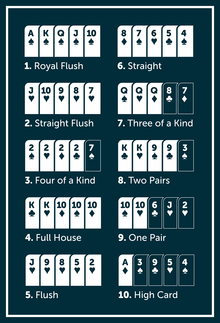
- Mathematics – Poker: The odds of being dealt a royal flush in poker are 649,739 to 1 against, for a probability of 1.5×10−6 (0.00015%).[6]
- Mathematics – Poker: The odds of being dealt a straight flush (other than a royal flush) in poker are 72,192 to 1 against, for a probability of 1.4×10−5 (0.0014%).
- Mathematics – Poker: The odds of being dealt a four of a kind in poker are 4,164 to 1 against, for a probability of 2.4 ×10−4 (0.024%).
10−3
(0.001; 1000−1; one thousandth)
ISO: milli- (m)
- Mathematics – Poker: The odds of being dealt a full house in poker are 693 to 1 against, for a probability of 1.4 × 10−3 (0.14%).
- Mathematics – Poker: The odds of being dealt a flush in poker are 507.8 to 1 against, for a probability of 1.9 × 10−3 (0.19%).
- Mathematics – Poker: The odds of being dealt a straight in poker are 253.8 to 1 against, for a probability of 4 × 10−3 (0.39%).
- Physics: α = 0.007297352570(5), the fine-structure constant.
10−2
(0.01; one hundredth)
ISO: centi- (c)
- Mathematics – Lottery: The odds of winning any prize in the UK National Lottery, with a single ticket, under the rules as of 2003, are 54 to 1 against, for a probability of about 0.018 (1.8%).
- Mathematics – Poker: The odds of being dealt a three of a kind in poker are 46 to 1 against, for a probability of 0.021 (2.1%).
- Mathematics – Lottery: The odds of winning any prize in the Powerball, with a single ticket, under the rules as of 2015, are 24.87 to 1 against, for a probability of 0.0402 (4.02%).
- Mathematics – Poker: The odds of being dealt two pair in poker are 20 to 1 against, for a probability of 0.048 (4.8%).
10−1
(0.1; one tenth)
ISO: deci- (d)
- Legal history: 10% was widespread as the tax raised for income or produce in the ancient and medieval period; see tithe.
- Mathematics – Poker: The odds of being dealt only one pair in poker are about 5 to 2 against (2.37 to 1), for a probability of 0.42 (42%).
- Mathematics – Poker: The odds of being dealt no pair in poker are nearly 1 to 2, for a probability of about 0.5 (50%).
100
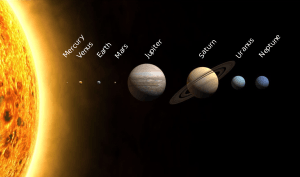
(1; one)
- Demography: The population of Monowi, an incorporated village in Nebraska, United States, was one in 2010.
- Religion: One is the number of gods in Judaism, Christianity, and Islam (monotheistic religions)
- Mathematics: √2 ≈ 1.414213562373095049, the ratio of the diagonal of a square to its side length.
- Mathematics: φ ≈ 1.618033988749894848, the golden ratio.
- Mathematics: √3 ≈ 1.732050807568877293, the ratio of the diagonal of a unit cube.
- Mathematics: the number system understood by most computers, the binary system, uses 2 digits: 0 and 1.
- Mathematics: √5 ≈ 2.236 067 9775, the correspondant to the diagonal of a rectangle whose side lengths are 1 and 2.
- Mathematics: e ≈ 2.718281828459045087, the base of the natural logarithm.
- Mathematics: the number system understood by ternary computers, the ternary system, uses 3 digits: 0, 1, and 2.
- Mathematics: π ≈ 3.141592653589793238, the ratio of a circle's circumference to its diameter.
- Religion: The Four Noble Truths in Buddhism.
- Biology: 7 ± 2, in cognitive science, George A. Miller's estimate of the number of objects that can be simultaneously held in human working memory.
- Music: 7 notes in a major or minor scale.
- Astronomy: 8 planets in the Solar System.
- Religion: the Eightfold Path in Buddhism.
- Literature: 9 circles of Hell in Inferno by Dante Alighieri.
101
(10; ten)
ISO: deca- (da)
- Demography: The population of Pesnopoy, a village in Bulgaria, was 10 in 2007.
- Human scale: There are 10 digits on a pair of human hands, and 10 toes on a pair of human feet.
- Mathematics: The number system used in everyday life, the decimal system, has 10 digits: 0, 1, 2, 3, 4, 5, 6, 7, 8, 9.
- Religion: the Ten Commandments in Judaism and Christianity
- Music: The number of notes (12) in a chromatic scale.
- Music: The number (15) of completed, numbered string quartets by Ludwig van Beethoven and Dmitri Shostakovich
- Linguistics: The Finnish language has fifteen noun cases.
- Mathematics: The hexadecimal system, a common number system used in computer programming, uses 16 digits where the last 6 are usually represented by letters: 0, 1, 2, 3, 4, 5, 6, 7, 8, 9, A, B, C, D, E, F.
- Science Fiction: The 23 enigma plays a prominent role in the plot of The Illuminatus! Trilogy by Robert Shea and Robert Anton Wilson.
- Music: a combined total of 24 major and minor keys, also the number of works in some musical cycles of J. S. Bach, Frédéric Chopin, Alexander Scriabin, and Dmitri Shostakovich.
- Alphabetic writing: There are 26 letters in the Latin-derived English alphabet.
- Science Fiction: The number 42, in the novel The Hitchhiker's Guide to the Galaxy by Douglas Adams, is the Answer to the Ultimate Question of Life, the Universe, and Everything which is calculated by an enormous supercomputer over a period of 7.5 million years.
- Biology: Each human cell contains 46 chromosomes.
- Phonology: There are 47 phonemes in English phonology in Received Pronunciation.
- Music: There are 88 keys on a grand piano.
102
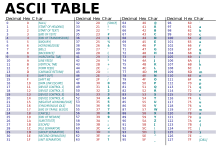
(100; hundred)
ISO: hecto- (h)
- Demography: The population of Nassau Island, part of the Cook Islands, is around 100.
- Music: There are 104 numbered symphonies of Franz Josef Haydn.
- European history: Groupings of 100 homesteads was a common administrative unit in Northern Europe and Great Britain (see Hundred (county division)).
- Chemistry: 118 chemical elements have been discovered or synthesized as of 2016.
- Computing: There are 128 characters in the ASCII character set.
- Phonology: The Taa language is estimated to have between 130 and 164 distinct phonemes.
- Political Science: There were 193 member states of the United Nations as of 2011.
- Computing: A GIF image (or an 8-bit image) supports maximum 256 (=28) colors.
- Music: the highest number (626) in the Köchel catalogue of works of Wolfgang Amadeus Mozart
- Demography: Vatican City, the least populous country, has an approximate population of 800 as of 2018.
103

(1000; thousand)
ISO: kilo- (k)
- Demography: The population of Ascension Island is 1,122.
- Music: 1,128: number of known extant works by Johann Sebastian Bach recognized in the Bach-Werke-Verzeichnis as of 2017
- Typesetting: 2,000–3,000 letters on a typical typed page of text.
- Mathematics: 2,520 (5×7×8×9 or 23×32×5×7) is the least common multiple of every positive integer under (and including) 10.
- Terrorism: 2,996 persons (including 19 terrorists) died in the terrorist attacks of September 11, 2001.
- Biology: the DNA of the simplest viruses has 3,000 base pairs.[7]
- Military history: 4,200 (Republic) or 5,200 (Empire) was the standard size of a Roman legion.
- Linguistics: Estimates for the linguistic diversity of living human languages or dialects range between 5,000 and 10,000 (SIL Ethnologue in 2009 listed 6,909 known living languages).
- Astronomy — Catalogues: There are 7,840 deep-sky objects in the NGC Catalogue from 1888.
- Lexicography: 8,674 unique words in the Hebrew Bible.
104
(10000; ten thousand or a myriad)
- Biology: Each neuron in the human brain is estimated to connect to 10,000 others.
- Demography: The population of Tuvalu was 10,544 in 2007.
- Lexicography: 14,500 unique English words occur in the King James Version of the Bible.
- Language: There are 20,000–40,000 distinct Chinese characters.
- Biology: Each human being is estimated to have 20,000 coding genes.[8]
- Grammar: Each regular verb in Cherokee can have 21,262 inflected forms.
- Mathematics: 65,537 is the largest known Fermat prime.
- Memory: As of 2015, the largest number of decimal places of π that have been recited from memory is 70,030.[9]
105

(100000; one hundred thousand or a lakh).
- Demography: The population of Saint Vincent and the Grenadines was 100,982 in 2009.
- Biology – Strands of hair on a head: The average human head has about 100,000–150,000 strands of hair.
- Literature: approximately 100,000 verses (shlokas) in the Mahabharata.
- Language: 267,000 words in James Joyce's Ulysses.
- Mathematics: 294,000 – The approximate number of entries in The On-Line Encyclopedia of Integer Sequences as of November 2017.[10]
- Genocide: 300,000 people killed in the Rape of Nanking.
- Language – English words: The New Oxford Dictionary of English contains about 360,000 definitions for English words.
- Literature: 564,000 words in War and Peace by Leo Tolstoy.
- Literature: 930,000 words in the King James Version of the Bible.
- Mathematics: There are 933,120 possible combinations on the Pyraminx.
106
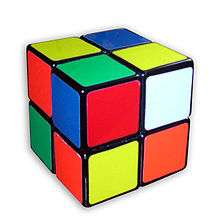
(1000000; 10002; long and short scales: one million)
ISO: mega- (M)
- Demography: The population of Riga, Latvia was 1,003,949 in 2004, according to Eurostat.
- Biology – Species: The World Resources Institute claims that approximately 1.4 million species have been named, out of an unknown number of total species (estimates range between 2 and 100 million species). Some scientists give 8.8 million species as an exact figure.
- Genocide: Approximately 800,000–1,500,000 (1.5 million) Armenians were killed in the Armenian Genocide.
- Linguistics: The number of possible conjugations for each verb in the Archi language is 1,502,839.[11]
- Info: The freedb database of CD track listings has around 1,750,000 entries as of June 2005.
- War: 1,857,619 casualties at the Battle of Stalingrad.
- Mathematics – Playing cards: There are 2,598,960 different 5-card poker hands that can be dealt from a standard 52-card deck.
- Mathematics: There are 3,149,280 possible positions for the Skewb.
- Mathematics -Rubik's Cube: 3,674,160 is the number of combinations for the Pocket Cube (2×2×2 Rubik's Cube).
- Info – Web sites: As of August 15, 2020, Wikipedia contains approximately 6,140,000 articles in the English language.
- Geography/Computing – Geographic places: The NIMA GEOnet Names Server contains approximately 3.88 million named geographic features outside the United States, with 5.34 million names. The USGS Geographic Names Information System claims to have almost 2 million physical and cultural geographic features within the United States.
- Genocide: Approximately 5,100,000–6,200,000 Jews were killed in the Holocaust.
107
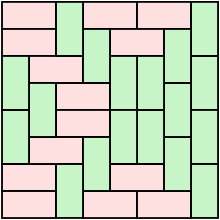
(10000000; a crore; long and short scales: ten million)
- Demography: The population of Haiti was 10,085,214 in 2010.
- Genocide: an estimated 12 million persons shipped from Africa to the New World in the Atlantic slave trade.
- Mathematics: 12,988,816 is the number of domino tilings of an 8×8 checkerboard.
- Computing: 16,777,216 different colors can be generated using the hex code system in HTML (It has been estimated that the trichromatic color vision of the human eye can only distinguish about 1,000,000 different colors).
- Science Fiction: In Isaac Asimov's Galactic Empire, in 22,500 CE, there are 25,000,000 different inhabited planets in the Galactic Empire, all inhabited by humans in Asimov's "human galaxy" scenario.
- Internet – YouTube: There are estimated to be about 31 million YouTube channels with at least five subscribers, posting 500 hours of video every minute.[12]
- Literature: Wikipedia contains a total of around 54 million articles in 300 languages as of June 2020.
108
(100000000; long and short scales: one hundred million)
- Demography: The population of the Philippines was 100,981,437 in 2015.
- Info – Books: The British Library claims that it holds over 150 million items. The Library of Congress claims that it holds approximately 148 million items. See The Gutenberg Galaxy.
- Mathematics: More than 215,000,000 mathematical constants are collected on the Plouffe's Inverter as of 2010.[13]
- Mathematics: 275,305,224 is the number of 5×5 normal magic squares, not counting rotations and reflections. This result was found in 1973 by Richard Schroeppel.
- Mathematics: 358,833,097 stellations of the rhombic triacontahedron.
- Info – Web sites: As of November 2011, the Netcraft web survey estimates that there are 525,998,433 (526 million) distinct websites.
- Astronomy – Cataloged stars: The Guide Star Catalog II has entries on 998,402,801 distinct astronomical objects.
109
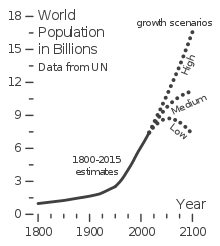
(1000000000; 10003; short scale: one billion; long scale: one thousand million, or one milliard)
ISO: giga- (G)
- Demography: The population of Africa reached 1,000,000,000 sometime in 2009.
- Demographics – India: 1,381,000,000 – approximate population of India in 2020.
- Transportation – Cars: As of 2018, there are approximately 1.4 billion cars in the world, corresponding to around 18% of the human population.[14]
- Demographics – China: 1,439,000,000 – approximate population of the People's Republic of China in 2020.
- Internet: Approximately 1,500,000,000 active users were on Facebook as of October 2015.[15]
- Computing – Computational limit of a 32-bit CPU: 2,147,483,647 is equal to 231−1, and as such is the largest number which can fit into a signed (two's complement) 32-bit integer on a computer.
- Biology – base pairs in the genome: approximately 3×109 base pairs in the human genome.[8]
- Linguistics: 3,400,000,000 – the total number of speakers of Indo-European languages, of which 2,400,000,000 are native speakers; the other 1,000,000,000 speak Indo-European languages as a second language.
- Mathematics and computing: 4,294,967,295 (232 − 1), the product of the five known Fermat primes and the maximum value for a 32-bit unsigned integer in computing.
- Computing – IPv4: 4,294,967,296 (232) possible unique IP addresses.
- Computing: 4,294,967,296 – the number of bytes in 4 gibibytes; in computation, 32-bit computers can directly access 232 units (bytes) of address space, which leads directly to the 4-gigabyte limit on main memory.
- Mathematics: 4,294,967,297 is a Fermat number and semiprime. It is the smallest number of the form which is not a prime number.
- Demographics – world population: 7,750,000,000 – Estimated population for the world as of April 2020.
1010
(10000000000; short scale: ten billion; long scale: ten thousand million, or ten milliard)
- Biology – bacteria in the human body: There are roughly 1010 bacteria in the human mouth.[16]
- Computing – web pages: approximately 5.6×1010 web pages indexed by Google as of 2010.
1011
(100000000000; short scale: one hundred billion; long scale: hundred thousand million, or hundred milliard)
- Biology – Neurons in the brain: approximately (1±0.2) × 1011 neurons in the human brain.[17]
- Paleodemography – "Number of humans that have ever lived": approximately (1.2±0.3) × 1011 live births of anatomically modern humans since the beginning of the Upper Paleolithic.[18]
- Astronomy – stars in our galaxy: of the order of 1011 stars in the Milky Way galaxy.[19]
1012
.jpg)
(1000000000000; 10004; short scale: one trillion; long scale: one billion)
ISO: tera- (T)
- Astronomy: Andromeda Galaxy, which is part of the same Local Group as our galaxy, contains about 1012 stars.
- Biology – Bacteria on the human body: The surface of the human body houses roughly 1012 bacteria.[16]
- Astronomy – Galaxies: A 2016 estimate says there are 2 × 1012 galaxies in the observable universe.[20]
- Biology: An estimate says there were 3.04 × 1012 trees on Earth in 2015.[21]
- Marine biology: 3,500,000,000,000 (3.5 × 1012) – estimated population of fish in the ocean.
- Mathematics: 7,625,597,484,987 – a number that often appears when dealing with powers of 3. It can be expressed as , , , and 33 or when using Knuth's up-arrow notation it can be expressed as and .
.jpg) 1014 Stars located inside in IC 1101.
1014 Stars located inside in IC 1101. - Mathematics: 1013 – The approximate number of known non-trivial zeros of the Riemann zeta function as of 2004.[22]
- Mathematics – Known digits of π: As of March 2019, the number of known digits of π is 31,415,926,535,897 (3.14×1013).[23]
- Biology – approximately 1014 synapses in the human brain.[24]
- Astronomy: IC 1101, a supergiant elliptical galaxy located inside the Abell 2029 cluster, is estimated to have approximately 100 trillion (1014) stars inside the galaxy, making it the largest known galaxy in the Universe.
- Biology – Cells in the human body: The human body consists of roughly 1014 cells, of which only 1013 are human.[25][26] The remaining 90% non-human cells (though much smaller and constituting much less mass) are bacteria, which mostly reside in the gastrointestinal tract, although the skin is also covered in bacteria.
- Cryptography: 150,738,274,937,250 configurations of the plug-board of the Enigma machine used by the Germans in WW2 to encode and decode messages by cipher.
- Computing – MAC-48: 281,474,976,710,656 (248) possible unique physical addresses.
- Mathematics: 953,467,954,114,363 is the largest known Motzkin prime.
1015
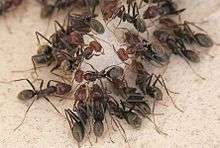
(1000000000000000; 10005; short scale: one quadrillion; long scale: one thousand billion, or one billiard)
ISO: peta- (P)
- Biology-Insects: 1,000,000,000,000,000 to 10,000,000,000,000,000 (1015 to 1016) – The estimated total number of ants on Earth alive at any one time (their biomass is approximately equal to the total biomass of the human race).[27]
- Computing: 9,007,199,254,740,992 (253) – number until which all integer values can exactly be represented in IEEE double precision floating-point format.
- Mathematics: 48,988,659,276,962,496 is the fifth taxicab number.
- Science Fiction: In Isaac Asimov's Galactic Empire, in what we call 22,500 CE there are 25,000,000 different inhabited planets in the Galactic Empire, all inhabited by humans in Asimov's "human galaxy" scenario, each with an average population of 2,000,000,000, thus yielding a total Galactic Empire population of approximately 50,000,000,000,000,000.
- Cryptography: There are 256 = 72,057,594,037,927,936 different possible keys in the obsolete 56-bit DES symmetric cipher.
1018
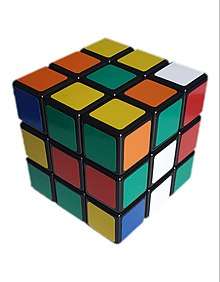
(1000000000000000000; 10006; short scale: one quintillion; long scale: one trillion)
ISO: exa- (E)
- Mathematics: Goldbach's conjecture has been verified for all n ≤ 4×1018; that is, all prime numbers up to that value at least have been computed, but not necessarily stored.
- Computing – Manufacturing: An estimated 6×1018 transistors were produced worldwide in 2008.[28]
- Computing – Computational limit of a 64-bit CPU: 9,223,372,036,854,775,807 (about 9.22×1018) is equal to 263−1, and as such is the largest number which can fit into a signed (two's complement) 64-bit integer on a computer.
- Mathematics – NCAA Basketball Tournament: There are 9,223,372,036,854,775,808 (263) possible ways to enter the bracket.
- Mathematics – Bases: 9,439,829,801,208,141,318 (≈9.44×1018) is the 10th and (by conjecture) largest number with more than one digit that can be written from base 2 to base 18 using only the digits 0 to 9, meaning the digits for 10 to 17 are not needed in bases above 10.[29]
- Biology – Insects: It has been estimated that the insect population of the Earth is about 1019.[30]
- Mathematics – Answer to the wheat and chessboard problem: When doubling the grains of wheat on each successive square of a chessboard, beginning with one grain of wheat on the first square, the final number of grains of wheat on all 64 squares of the chessboard when added up is 264−1 = 18,446,744,073,709,551,615 (≈1.84×1019).
- Mathematics – Legends: The Tower of Brahma legend tells about a Hindu temple containing a large room with three posts, on one of which are 64 golden discs, and the object of the mathematical game is for the Brahmins in this temple to move all of the discs to another pole so that they are in the same order, never placing a larger disc above a smaller disc, moving only one at a time. Using the simplest algorithm for moving the disks, it would take 264−1 = 18,446,744,073,709,551,615 (≈1.84×1019) turns to complete the task (the same number as the wheat and chessboard problem above).[31].
- Computing – IPv6: 18,446,744,073,709,551,616 (264; ≈1.84×1019) possible unique /64 subnetworks.
- Mathematics – Rubik's Cube: There are 43,252,003,274,489,856,000 (≈4.33×1019) different positions of a 3×3×3 Rubik's Cube.
- Password strength: Usage of the 95-character set found on standard computer keyboards for a 10-character password yields a computationally intractable 59,873,693,923,837,890,625 (9510, approximately 5.99×1019) permutations.
- Economics: Hyperinflation in Zimbabwe estimated in February 2009 by some economists at 10 sextillion percent,[32] or a factor of 1020
1021
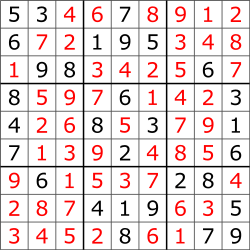
(1000000000000000000000; 10007; short scale: one sextillion; long scale: one thousand trillion, or one trilliard)
ISO: zetta- (Z)
- Geo – Grains of sand: All the world's beaches combined have been estimated to hold roughly 1021 grains of sand.[33]
- Computing – Manufacturing: Intel predicted that there would be 1.2×1021 transistors in the world by 2015[34] and Forbes estimated that 2.9×1021 transistors had been shipped up to 2014.[35]
- Mathematics – Sudoku: There are 6,670,903,752,021,072,936,960 (≈6.7×1021) 9×9 sudoku grids.[36]
- Astronomy – Stars: 70 sextillion = 7×1022, the estimated number of stars within range of telescopes (as of 2003).[37]
- Astronomy – Stars: in the range of 1023 to 1024 stars in the observable universe.[38]
- Mathematics: 146,361,946,186,458,562,560,000 (≈1.5×1023) is the fifth unitary perfect number.
- Chemistry – Physics: Avogadro constant (≈6.02×1023) is the number of constituents (e.g. atoms or molecules) in one mole of a substance, defined for convenience as expressing the order of magnitude separating the molecular from the macroscopic scale.
1024
(1000000000000000000000000; 10008; short scale: one septillion; long scale: one quadrillion)
ISO: yotta- (Y)
- Mathematics: 2,833,419,889,721,787,128,217,599 (≈2.8×1024) is a Woodall prime.
- Mathematics: 286 = 77,371,252,455,336,267,181,195,264 is the largest known power of two not containing the digit '0' in its decimal representation.[39]
1027
(1000000000000000000000000000; 10009; short scale: one octillion; long scale: one thousand quadrillion, or one quadrilliard)
- Biology – Atoms in the human body: the average human body contains roughly 7×1027 atoms.[40]
- Mathematics – Poker: the number of unique combinations of hands and shared cards in a 10-player game of Texas hold 'em is approximately 2.117×1028.
1030
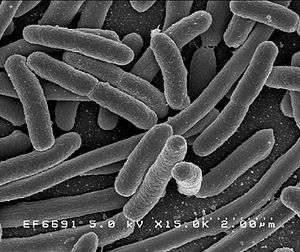
(1000000000000000000000000000000; 100010; short scale: one nonillion; long scale: one quintillion)
- Biology – Bacterial cells on Earth: The number of bacterial cells on Earth is estimated at around 5,000,000,000,000,000,000,000,000,000,000, or 5 × 1030.[41]
- Mathematics: The number of partitions of 1000 is 24,061,467,864,032,622,473,692,149,727,991.[42]
- Mathematics: 368 = 278,128,389,443,693,511,257,285,776,231,761 is the largest known power of three not containing the digit '0' in its decimal representation.
- Mathematics: 2108 = 324,518,553,658,426,726,783,156,020,576,256 is the largest known power of two not containing the digit '9' in its decimal representation.[43]
1033
(1000000000000000000000000000000000; 100011; short scale: one decillion; long scale: one thousand quintillion, or one quintilliard)
- Mathematics – Alexander's Star: There are 72,431,714,252,715,638,411,621,302,272,000,000 (about 7.24×1034) different positions of Alexander's Star.
1036
(1000000000000000000000000000000000000; 100012; short scale: one undecillion; long scale: one sextillion)
- Physics: ke e2 / Gm2, the ratio of the electromagnetic to the gravitational forces between two protons, is roughly 1036.
- Mathematics: = 170,141,183,460,469,231,731,687,303,715,884,105,727 (≈1.7×1038) is a double Mersenne prime.
- Computing: 2128 = 340,282,366,920,938,463,463,374,607,431,768,211,456 (≈3.40282367×1038), the theoretical maximum number of Internet addresses that can be allocated under the IPv6 addressing system, one more than the largest value that can be represented by a single-precision IEEE floating-point value, the total number of different Universally Unique Identifiers (UUIDs) that can be generated.
- Cryptography: 2128 = 340,282,366,920,938,463,463,374,607,431,768,211,456 (≈3.40282367×1038), the total number of different possible keys in the AES 128-bit key space (symmetric cipher).
1039
(1000000000000000000000000000000000000000; 100013; short scale: one duodecillion; long scale: one thousand sextillion, or one sextilliard)
- Cosmology: The Eddington–Dirac number is roughly 1040.
- Mathematics: 69,720,375,229,712,477,164,533,808,935,312,303,556,800 (≈6.97×1040) is the least common multiple of every integer from 1 to 100.
1042 to 10100
(1000000000000000000000000000000000000000000; 100014; short scale: one tredecillion; long scale: one septillion)
- Mathematics: 141×2141+1 = 393,050,634,124,102,232,869,567,034,555,427,371,542,904,833 (≈3.93×1044) is the second Cullen prime.
- Mathematics: There are 7,401,196,841,564,901,869,874,093,974,498,574,336,000,000,000 (≈7.4×1045) possible permutations for the Rubik's Revenge (4×4×4 Rubik's Cube).
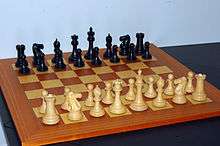
- Chess: 4.52×1046 is a proven upper bound for the number of legal chess positions.[44]
- Geo: 1.33×1050 is the estimated number of atoms in Earth.
- Mathematics: 808,017,424,794,512,875,886,459,904,961,710,757,005,754,368,000,000,000 (≈8.08×1053) is the order of the monster group.
- Cryptography: 2192 = 6,277,101,735,386,680,763,835,789,423,207,666,416,102,355,444,464,034,512,896 (6.27710174×1057), the total number of different possible keys in the AES 192-bit key space (symmetric cipher).
- Cosmology: 8×1060 is roughly the number of Planck time intervals since the universe is theorised to have been created in the Big Bang 13.799 ± 0.021 billion years ago.[45]
- Cosmology: 1×1063 is Archimedes' estimate in The Sand Reckoner of the total number of grains of sand that could fit into the entire cosmos, the diameter of which he estimated in stadia to be what we call 2 light years.
- Mathematics – Cards: 52! = 80,658,175,170,943,878,571,660,636,856,403,766,975,289,505,440,883,277,824,000,000,000,000 (≈8.07×1067) – the number of ways to order the cards in a 52-card deck.
- Mathematics: There are ≈1.01×1068 possible combinations for the Megaminx.
- Mathematics: 1,808,422,353,177,349,564,546,512,035,512,530,001,279,481,259,854,248,860,454,348,989,451,026,887 (≈1.81×1072) – The largest known prime factor found by ECM factorization as of 2010.[46]
- Mathematics: There are 282,870,942,277,741,856,536,180,333,107,150,328,293,127,731,985,672,134,721,536,000,000,000,000,000 (≈2.83×1074) possible permutations for the Professor's Cube (5×5×5 Rubik's Cube).
- Cryptography: 2256 = 115,792,089,237,316,195,423,570,985,008,687,907,853,269,984,665,640,564,039,457,584,007,913,129,639,936 (≈1.15792089×1077), the total number of different possible keys in the AES 256-bit key space (symmetric cipher).
- Cosmology: Various sources estimate the total number of fundamental particles in the observable universe to be within the range of 1080 to 1085.[47][48] However, these estimates are generally regarded as guesswork. (Compare the Eddington number, the estimated total number of protons in the observable universe.)
- Computing: 9.999 999×1096 is equal to the largest value that can be represented in the IEEE decimal32 floating-point format.
- Computing: 69! (roughly 1.7112245×1098), is the highest factorial value that can be represented on a calculator with two digits for powers of ten without overflow.
- Mathematics: One googol, 1×10100, 1 followed by one hundred zeros, or 10,000,000,000,000,000,000,000,000,000,000,000,000,000,000,000,000,000,000,000,000,000,000,000,000,000,000,000,000,000,000,000,000,000.
10100 (one googol) to 101000
(10000000000000000000000000000000000000000000000000000000000000000000000000000000000000000000000000000; short scale: ten duotrigintillion; long scale: ten thousand sexdecillion, or ten sexdecillard)[49]
- Mathematics: There are 157 152 858 401 024 063 281 013 959 519 483 771 508 510 790 313 968 742 344 694 684 829 502 629 887 168 573 442 107 637 760 000 000 000 000 000 000 000 000 (≈1.57×10116) distinguishable permutations of the V-Cube 6 (6×6×6 Rubik's Cube).
- Chess: Shannon number, 10120, a lower bound of the game-tree complexity of chess.
- Physics: 10120, discrepancy between the observed value of the cosmological constant and a naive estimate based on Quantum Field Theory and the Planck energy.
- Physics: 8×10120, ratio of the mass-energy in the observable universe to the energy of a photon with a wavelength the size of the observable universe.
- History – Religion: Asaṃkhyeya is a Buddhist name for the number 10140. It is listed in the Avatamsaka Sutra and metaphorically means "innumerable" in the Sanskrit language of ancient India.
- Xiangqi: 10150, an estimation of the game-tree complexity of xiangqi.
- Mathematics: There are 19 500 551 183 731 307 835 329 126 754 019 748 794 904 992 692 043 434 567 152 132 912 323 232 706 135 469 180 065 278 712 755 853 360 682 328 551 719 137 311 299 993 600 000 000 000 000 000 000 000 000 000 000 000 (≈1.95×10160) distinguishable permutations of the V-Cube 7 (7×7×7 Rubik's Cube).
- Go: There are 208 168 199 381 979 984 699 478 633 344 862 770 286 522 453 884 530 548 425 639 456 820 927 419 612 738 015 378 525 648 451 698 519 643 907 259 916 015 628 128 546 089 888 314 427 129 715 319 317 557 736 620 397 247 064 840 935 (≈2.08×10170) legal positions in the game of Go. See Go and mathematics.
- Board games: 3.457×10181, number of ways to arrange the tiles in English Scrabble on a standard 15-by-15 Scrabble board.
- Physics: 10186, approximate number of Planck volumes in the observable universe.
- Physics: 7×10245, approximate spacetime volume of the history of the observable universe in Planck units.[50]
- Computing: 1.797 693 134 862 315 807×10308 is approximately equal to the largest value that can be represented in the IEEE double precision floating-point format.
- Computing: (10 – 10−15)×10384 is equal to the largest value that can be represented in the IEEE decimal64 floating-point format.
101000 to 1010100 (one googolplex)
- Mathematics: There are approximately 1.869×104099 distinguishable permutations of the world's largest Rubik's cube (33×33×33).
- Computing: 1.189 731 495 357 231 765 05×104932 is approximately equal to the largest value that can be represented in the IEEE 80-bit x86 extended precision floating-point format.
- Computing: 1.189 731 495 357 231 765 085 759 326 628 007 0×104932 is approximately equal to the largest value that can be represented in the IEEE quadruple precision floating-point format.
- Computing: (10 – 10−33)×106144 is equal to the largest value that can be represented in the IEEE decimal128 floating-point format.
- Computing: 1010,000 − 1 is equal to the largest value that can be represented in Windows Phone's calculator.
- Mathematics: 26384405 + 44052638 is a 15,071-digit Leyland prime; the largest which has been proven as of 2010.[51]
- Mathematics: 3,756,801,695,685 × 2666,669 ± 1 are 200,700-digit twin primes; the largest known as of December 2011.[52]
- Mathematics: 18,543,637,900,515 × 2666,667 − 1 is a 200,701-digit Sophie Germain prime; the largest known as of April 2012.[53]
- Mathematics: approximately 7.76 × 10206,544 cattle in the smallest herd which satisfies the conditions of Archimedes' cattle problem.
- Mathematics: 10290,253 – 2 × 10145,126 + 1 is a 290,253-digit palindromic prime, the largest known as of April 2012.[54]
- Mathematics: 1,098,133# – 1 is a 476,311-digit primorial prime; the largest known as of March 2012.[55]
- Mathematics: 150,209! + 1 is a 712,355-digit factorial prime; the largest known as of August 2013.[56]
- Mathematics – Literature: Jorge Luis Borges' Library of Babel contains at least 251,312,000 ≈ 1.956 × 101,834,097 books (this is a lower bound).[57]
- Mathematics: 475,856524,288 + 1 is a 2,976,633-digit Generalized Fermat prime, the largest known as of December 2012.[58]
- Mathematics: 19,249 × 213,018,586 + 1 is a 3,918,990-digit Proth prime, the largest known Proth prime[59] and non-Mersenne prime as of 2010.[60]
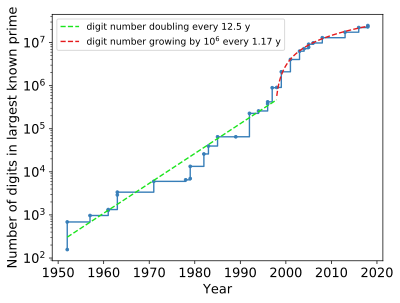
- Mathematics: 282,589,933 − 1 is a 24,862,048-digit Mersenne prime; the largest known prime of any kind as of 2019.[60]
- Mathematics: 282,589,932 × (282,589,933 − 1) is a 49,724,095-digit perfect number, the largest known as of 2019.[61]
- Mathematics – History: 108×1016, largest named number in Archimedes' Sand Reckoner.
- Mathematics: 10googol (), a googolplex. A number 1 followed by 1 googol zeros. Carl Sagan has estimated that 1 googolplex, fully written out, would not fit in the observable universe because of its size, while also noting that one could also write the number as 1010100.[62]
Larger than 1010100
(One googolplex; 10googol; short scale: googolplex; long scale: googolplex)
- Mathematics–Literature: The number of different ways in which the books in Jorge Luis Borges' Library of Babel can be arranged is , the factorial of the number of books in the Library of Babel.
- Cosmology: In chaotic inflation theory, proposed by physicist Andrei Linde, our universe is one of many other universes with different physical constants that originated as part of our local section of the multiverse, owing to a vacuum that had not decayed to its ground state. According to Linde and Vanchurin, the total number of these universes is about .[63]
- Mathematics: , order of magnitude of an upper bound that occurred in a proof of Skewes (this was later estimated to be closer to 1.397 × 10316).
- Cosmology: The estimated number of Planck time units for quantum fluctuations and tunnelling to generate a new Big Bang is estimated to be .
- Mathematics: , a number in the googol family called a googolplexplex, googolplexian, or googolduplex. 1 followed by a googolplex zeros, or 10googolplex
- Mathematics: , order of magnitude of another upper bound in a proof of Skewes.
- Mathematics: Steinhaus' mega lies between 10↑↑257 and 10↑↑258.
- Mathematics: Moser's number, "2 in a mega-gon" in Steinhaus–Moser notation, is approximately equal to 10↑↑↑...↑↑↑10, where there are 10↑↑257 arrows, the last four digits are ...1056.
- Mathematics: Graham's number, the last ten digits of which are ...2464195387. Arises as an upper bound solution to a problem in Ramsey theory. Representation in powers of 10 would be impractical (the number of 10s in the power tower would be virtually indistinguishable from the number itself).
- Mathematics: TREE(3): appears in relation to a theorem on trees in graph theory. Representation of the number is difficult, but one weak lower bound is AA(187196)(1), where A(n) is a version of the Ackermann function.
- Mathematics: SSCG(3): appears in relation to the Robertson–Seymour theorem. Known to be greater than both TREE(3) and TREE(TREE(…TREE(3)…)) (the TREE function nested TREE(3) times with TREE(3) at the bottom).
See also
- Conway chained arrow notation
- Encyclopedic size comparisons on Wikipedia
- Fast-growing hierarchy
- Large numbers
- List of numbers
- Mathematical constant
- Names of large numbers
- Names of small numbers
- Planck units
- Power of 10
References
- Kittel, Charles and Herbert Kroemer (1980). Thermal Physics (2nd ed.). W. H. Freeman Company. p. 53. ISBN 978-0-7167-1088-2.
- There are around 130,000 letters and 199,749 total characters in Hamlet; 26 letters ×2 for capitalization, 12 for punctuation characters = 64, 64199749 ≈ 10360,783.
- Robert Matthews. "What are the odds of shuffling a deck of cards into the right order?". Science Focus. Retrieved December 10, 2018.
- www.BridgeHands.com, Sales. "Probabilities Miscellaneous: Bridge Odds". Archived from the original on 2009-10-03.
- Walraven, P. L.; Lebeek, H. J. (1963). "Foveal Sensitivity of the Human Eye in the Near Infrared". J. Opt. Soc. Am. 53 (6): 765–766. doi:10.1364/josa.53.000765. PMID 13998626.
- Courtney Taylor. "The Probability of Being Dealt a Royal Flush in Poker". ThoughtCo. Retrieved December 10, 2018.
- Mason, W S; Seal, G; Summers, J (1980-12-01). "Virus of Pekin ducks with structural and biological relatedness to human hepatitis B virus". Journal of Virology. 36 (3): 829–836. doi:10.1128/JVI.36.3.829-836.1980. ISSN 0022-538X. PMC 353710. PMID 7463557.
- "Homo sapiens – Ensembl genome browser 87". www.ensembl.org. Archived from the original on 2017-05-25. Retrieved 2017-01-28.
- "Pi World Ranking List". Archived from the original on 2017-06-29.
- Sloane, N. J. A. (ed.). "Sequence A283670". The On-Line Encyclopedia of Integer Sequences. OEIS Foundation. Retrieved 2017-03-15.
- Kibrik, A. E. (2001). "Archi (Caucasian—Daghestanian)", The Handbook of Morphology, Blackwell, pg. 468
- Funk, Matthias (31 January 2020). "How Many YouTube Channels Are There?". tubics. Retrieved 2020-05-19.
- Plouffe's Inverter Archived 2005-08-12 at the Wayback Machine
- "How many cars are there in the world?". carsguide. 6 August 2018. Retrieved 18 May 2020.
- Christof Baron (2015). "Facebook users worldwide 2016 | Statista". Statista. statista.com. Archived from the original on 2016-09-09.
- "Earth microbes on the moon". Science@Nasa. 1 September 1998. Archived from the original on 23 March 2010. Retrieved 2 November 2010.
- "there was, to our knowledge, no actual, direct estimate of numbers of cells or of neurons in the entire human brain to be cited until 2009. A reasonable approximation was provided by Williams and Herrup (1988), from the compilation of partial numbers in the literature. These authors estimated the number of neurons in the human brain at about 85 billion [...] With more recent estimates of 21–26 billion neurons in the cerebral cortex (Pelvig et al., 2008 ) and 101 billion neurons in the cerebellum (Andersen et al., 1992 ), however, the total number of neurons in the human brain would increase to over 120 billion neurons." Herculano-Houzel, Suzana (2009). "The human brain in numbers: a linearly scaled-up primate brain". Front. Hum. Neurosci. 3: 31. doi:10.3389/neuro.09.031.2009. PMC 2776484. PMID 19915731.
- Kapitsa, Sergei P (1996). "The phenomenological theory of world population growth". Physics-Uspekhi. 39 (1): 57–71. Bibcode:1996PhyU...39...57K. doi:10.1070/pu1996v039n01abeh000127. (citing the range of 80 to 150 billion, citing K. M. Weiss, Human Biology 56637, 1984, and N. Keyfitz, Applied Mathematical Demography, New York: Wiley, 1977). C. Haub, "How Many People Have Ever Lived on Earth?", Population Today 23.2), pp. 5–6, cited an estimate of 105 billion births since 50,000 BC, updated to 107 billion as of 2011 in Haub, Carl (October 2011). "How Many People Have Ever Lived on Earth?". Population Reference Bureau. Archived from the original on April 24, 2013. Retrieved April 29, 2013. (due to the high infant mortality in pre-modern times, close to half of this number would not have lived past infancy).
- Elizabeth Howell, How Many Stars Are in the Milky Way? Archived 2016-05-28 at the Wayback Machine, Space.com, 21 May 2014 (citing estimates from 100 to 400 billion).
- Hollis, Morgan (13 October 2016). "A universe of two trillion galaxies". The Royal Astronomical Society. Retrieved 9 November 2017.
- Jonathan Amos (3 September 2015). "Earth's trees number 'three trillion'". BBC. Archived from the original on 6 June 2017.
- Xavier Gourdon (October 2004). "Computation of zeros of the Zeta function". Archived from the original on 15 January 2011. Retrieved 2 November 2010.
- Haruka Iwao, Emma (14 March 2019). "Pi in the sky: Calculating a record-breaking 31.4 trillion digits of Archimedes' constant on Google Cloud". Archived from the original on 19 October 2019. Retrieved 12 April 2019.
- Koch, Christof. Biophysics of computation: information processing in single neurons. Oxford university press, 2004.
- Savage, D. C. (1977). "Microbial Ecology of the Gastrointestinal Tract". Annual Review of Microbiology. 31: 107–33. doi:10.1146/annurev.mi.31.100177.000543. PMID 334036.
- Berg, R. (1996). "The indigenous gastrointestinal microflora". Trends in Microbiology. 4 (11): 430–5. doi:10.1016/0966-842X(96)10057-3. PMID 8950812.
- Bert Holldobler and E.O. Wilson The Superorganism: The Beauty, Elegance, and Strangeness of Insect Societies New York:2009 W.W. Norton Page 5
- "60th Birthday of Microelectronics Industry". Semiconductor Industry Association. 13 December 2007. Archived from the original on 13 October 2008. Retrieved 2 November 2010.
- Sequence A131646 Archived 2011-09-01 at the Wayback Machine in The On-Line Encyclopedia of Integer Sequences
- "Smithsonian Encyclopedia: Number of Insects Archived 2016-12-28 at the Wayback Machine". Prepared by the Department of Systematic Biology, Entomology Section, National Museum of Natural History, in cooperation with Public Inquiry Services, Smithsonian Institution. Accessed 27 December 2016. Facts about numbers of insects. Puts the number of individual insects on Earth at about 10 quintillion (1019).
- Ivan Moscovich, 1000 playthinks: puzzles, paradoxes, illusions & games, Workman Pub., 2001 ISBN 0-7611-1826-8.
- "Scores of Zimbabwe farms 'seized'". BBC. 23 February 2009. Archived from the original on 1 March 2009. Retrieved 14 March 2009.
- "To see the Universe in a Grain of Taranaki Sand". Archived from the original on 2012-06-30.
- "Intel predicts 1,200 quintillion transistors in the world by 2015". Archived from the original on 2013-04-05.
- "How Many Transistors Have Ever Shipped? – Forbes". Archived from the original on 30 June 2015. Retrieved 1 September 2015.
- "Sudoku enumeration". Archived from the original on 2006-10-06.
- "Star count: ANU astronomer makes best yet". The Australian National University. 17 July 2003. Archived from the original on July 24, 2005. Retrieved 2 November 2010.
- "Astronomers count the stars". BBC News. July 22, 2003. Archived from the original on August 13, 2006. Retrieved 2006-07-18. "trillions-of-earths-could-be-orbiting-300-sextillion-stars" van Dokkum, Pieter G.; Charlie Conroy (2010). "A substantial population of low-mass stars in luminous elliptical galaxies". Nature. 468 (7326): 940–942. arXiv:1009.5992. Bibcode:2010Natur.468..940V. doi:10.1038/nature09578. PMID 21124316. "How many stars?" Archived 2013-01-22 at the Wayback Machine; see mass of the observable universe
- (sequence A007377 in the OEIS)
- "Questions and Answers – How many atoms are in the human body?". Archived from the original on 2003-10-06.
- William B. Whitman; David C. Coleman; William J. Wiebe (1998). "Prokaryotes: The unseen majority". Proceedings of the National Academy of Sciences of the United States of America. 95 (12): 6578–6583. Bibcode:1998PNAS...95.6578W. doi:10.1073/pnas.95.12.6578. PMC 33863. PMID 9618454.
- (sequence A070177 in the OEIS)
- (sequence A035064 in the OEIS)
- John Tromp (2010). "John's Chess Playground". Archived from the original on 2014-06-01.
- Planck Collaboration (2016). "Planck 2015 results. XIII. Cosmological parameters (See Table 4 on page 31 of pfd)". Astronomy & Astrophysics. 594: A13. arXiv:1502.01589. Bibcode:2016A&A...594A..13P. doi:10.1051/0004-6361/201525830.
- Paul Zimmermann, "50 largest factors found by ECM Archived 2009-02-20 at the Wayback Machine".
- Matthew Champion, "Re: How many atoms make up the universe?" Archived 2012-05-11 at the Wayback Machine, 1998
- WMAP- Content of the Universe Archived 2016-07-26 at the Wayback Machine. Map.gsfc.nasa.gov (2010-04-16). Retrieved on 2011-05-01.
- "Names of large and small numbers". bmanolov.free.fr. Miscellaneous pages by Borislav Manolov. Archived from the original on 2016-09-30.
- "Richard Eldridge".
- Chris Caldwell, The Top Twenty: Elliptic Curve Primality Proof at The Prime Pages.
- Chris Caldwell, The Top Twenty: Twin Primes Archived 2013-01-27 at the Wayback Machine at The Prime Pages.
- Chris Caldwell, The Top Twenty: Sophie Germain (p) at The Prime Pages.
- Chris Caldwell, The Top Twenty: Palindrome at The Prime Pages.
- PrimeGrid's Primorial Prime Search Archived 2013-11-26 at the Wayback Machine
- Chris Caldwell, The Top Twenty: Factorial primes Archived 2013-04-10 at the Wayback Machine at The Prime Pages.
- From the third paragraph of the story: "Each book contains 410 pages; each page, 40 lines; each line, about 80 black letters." That makes 410 x 40 x 80 = 1,312,000 characters. The fifth paragraph tells us that "there are 25 orthographic symbols" including spaces and punctuation. The magnitude of the resulting number is found by taking logarithms. However, this calculation only gives a lower bound on the number of books as it does not take into account variations in the titles – the narrator does not specify a limit on the number of characters on the spine. For further discussion of this, see Bloch, William Goldbloom. The Unimaginable Mathematics of Borges' Library of Babel. Oxford University Press: Oxford, 2008.
- Chris Caldwell, The Top Twenty: Generalized Fermat Archived 2014-12-23 at the Wayback Machine at The Prime Pages.
- Chris Caldwell, The Top Twenty: Proth at The Prime Pages.
- Chris Caldwell, The Top Twenty: Largest Known Primes at The Prime Pages.
- Chris Caldwell, Mersenne Primes: History, Theorems and Lists at The Prime Pages.
- asantos (15 December 2007). "Googol and Googolplex by Carl Sagan" – via YouTube.
- Zyga, Lisa "Physicists Calculate Number of Parallel Universes" Archived 2011-06-06 at the Wayback Machine, PhysOrg, 16 October 2009.
External links
- Seth Lloyd's paper Computational capacity of the universe provides a number of interesting dimensionless quantities.
- Notable properties of specific numbers
- Clewett, James. "4,294,967,296 – The Internet is Full". Numberphile. Brady Haran.
